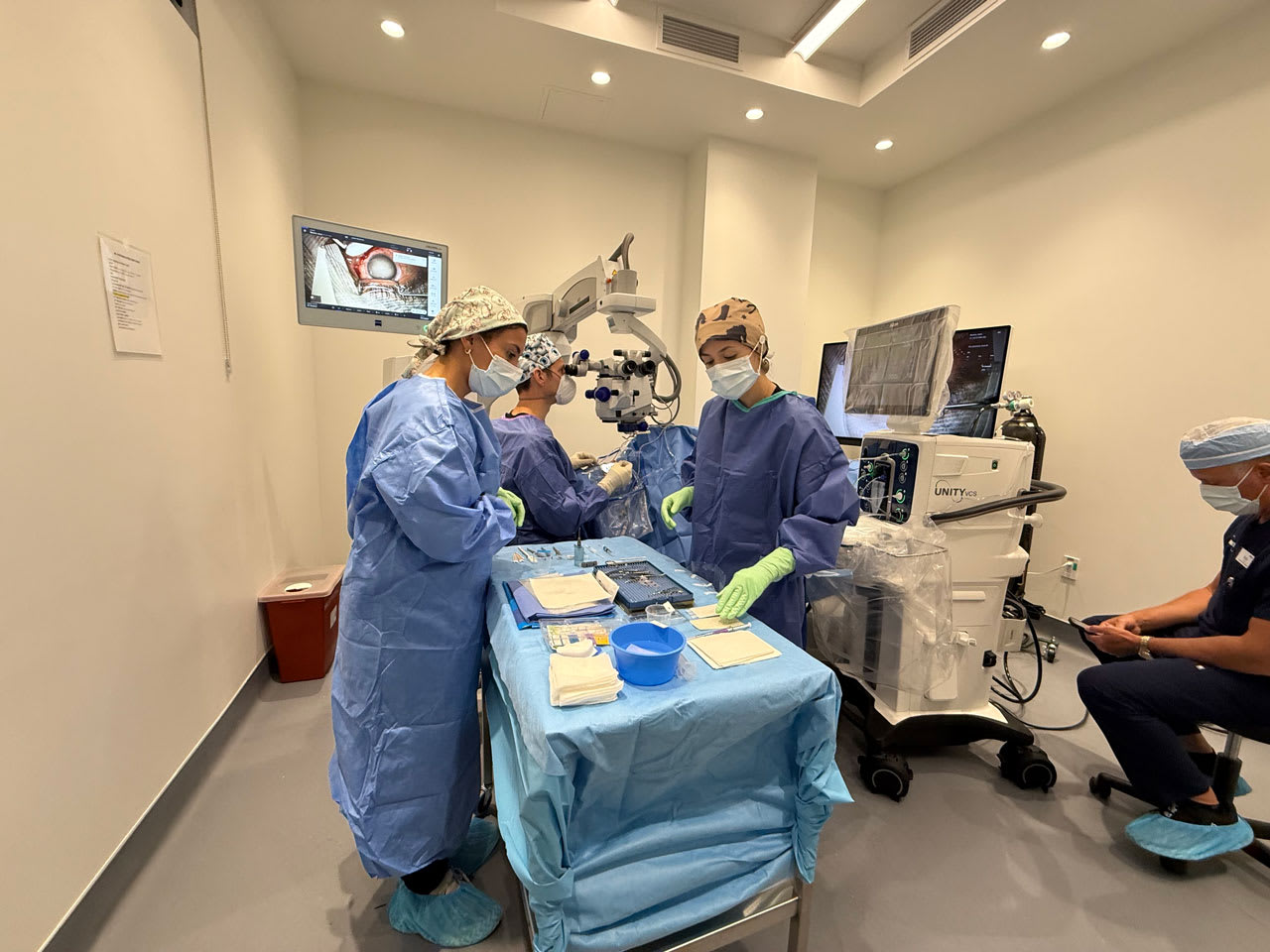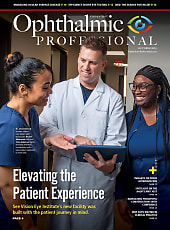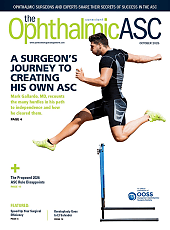A few years ago, our retina practice faced a persistent challenge: inconsistent access to hospital and ambulatory surgery center (ASC) operating rooms (ORs), particularly for urgent surgeries. Retinal detachments don’t wait for a convenient OR block, and I found myself repeatedly navigating delays that could jeopardize patients’ vision. This frustration led us to explore office-based surgery (OBS) as a solution—and the results have been transformative.
Since launching our office-based surgical suite in May 2022, we’ve completed hundreds of retina procedures in the office. An approach that originated to address emergent care gaps has grown into a reliable, safe, efficient, and patient-centered approach to retina surgery. I’d like to share my perspective on how we’ve built our OBS program, the procedures we perform, the benefits we’ve observed, and how others can begin offering similar care.

Why Move Retina Surgery Into the Office?
Retina surgery has evolved dramatically since its early days. Advances in small-gauge instrumentation, high-speed vitrectomy cutters, and wide-angle visualization systems have made today’s procedures more refined, less invasive, and more efficient. These technological leaps have laid the groundwork for transitioning appropriate surgical care from the hospital to the outpatient setting—and now, increasingly, to the office.
Cataract surgery has already blazed the trail, with thousands of successful office-based procedures performed in the United States. Retina procedures, although more complex, are following a similar trajectory. In our practice, we found that bringing surgery into the office improved patient access, eliminated scheduling bottlenecks, reduced costs, and gave us greater control over every aspect of the surgical experience.
We’ve found that a wide range of vitreoretinal surgeries can be safely and efficiently performed in the OBS environment, including pars plana vitrectomies for retinal detachment (including same-day repairs), dropped lens removals and secondary intraocular lens (IOL) placements, macular procedures such as epiretinal membrane (ERM) and macular hole repairs, silicone oil removals, and intraocular implant procedures. We’ve even performed selected scleral buckle procedures, usually for younger patients with acute, fovea-threatening detachments that couldn’t wait for a hospital’s operating room.
While not every case is suited for the office setting, many urgent and elective posterior segment surgeries can be transitioned safely with the right protocols and patient selection.
What Patients Are Right for OBS?
Careful patient selection is critical. In our practice, we generally avoid offering OBS to patients with significant systemic medical conditions, elevated anxiety levels, or those who may require general anesthesia or intensive anesthetic monitoring. These individuals are better served in the hospital or ASC, where broader medical support is available.
Ideal candidates for OBS are medically stable, comfortable with local or oral anesthesia, and often are patients who require timely intervention but face delays in traditional surgical settings. Office-based procedures are particularly well suited for urgent retinal cases, where rapid treatment can preserve vision.
Beyond clinical criteria, the patient experience is often enhanced in the office setting. Patients benefit from the continuity of care. Being treated by familiar staff in a familiar environment helps reduce anxiety and improve cooperation. Many procedures can be performed on the same day as diagnosis, eliminating the need for external scheduling, travel to another facility, or additional preoperative appointments—factors that often cause delays when operating in a hospital or ASC. This streamlined, patient-centered approach can make a meaningful difference in both clinical outcomes and overall satisfaction.
How We Handle Anesthesia
One of the most common questions I hear is, “How do you manage anesthesia in the office?” Our current technique relies primarily on local subconjunctival and sub-Tenon’s anesthesia. We’ve largely moved away from retrobulbar injections and eliminated intravenous (IV) sedation entirely. Here’s our basic 3-step anesthesia protocol:
- Preoperative topical and subconjunctival lidocaine, including over the planned trocar sites.
- Posterior sub-Tenon’s block after draping, using a soft cannula.
- Supplemental lidocaine as needed, particularly for laser or scleral depression.
We offer oral anxiolytics (such as diazepam or midazolam), but most patients decline them. In our experience, the familiarity of the office setting and the confidence we’re able to instill with our team help reduce anxiety and enhance cooperation.
This approach has proven both safe and effective. In fact, we recently compared pain scores between OBS patients (no IV sedation) and those undergoing the same procedures in the ASC with IV sedation. The results were comparable.
Creating the Surgical Space
Setting up an OBS suite requires thoughtful planning, but it doesn’t need to be overwhelming. Our suite closely resembles a traditional operating room in both form and function, meeting the same rigorous standards for sterility, safety, and workflow. The most critical components to consider are the physical space, accreditation, equipment, and staffing.
A dedicated sterile environment is essential, with appropriate HVAC systems, surgical lighting, and infection control protocols in place to ensure patient safety. Accreditation is another foundational step. In New York, for example, any facility performing office-based surgery must be certified by an approved body such as Quad A (formerly AAAASF), the Accreditation Association for Ambulatory Health Care (AAAHC), or The Joint Commission. We pursued Quad A certification, which required a thorough review of our policies, procedures, and physical infrastructure.
One of the major benefits of OBS is the ability to customize your surgical setup. We selected a vitrectomy platform, wide-angle viewing system, high-quality surgical microscope, and the core instrumentation needed for retina procedures. Since the equipment is chosen and maintained in-house, it meets our preferences and surgical needs.
Staffing also plays a pivotal role. Rather than hire new personnel, we trained our existing team—including technicians and scribes—to take on new roles as scrub techs, circulators, and sterilization staff. With the guidance of a consulting group, we developed training programs and compliance protocols to meet regulatory and accreditation requirements.
What surprised us most was how eagerly our staff embraced the chance to learn surgical skills. Their enthusiasm has not only contributed to a strong internal culture but also made our practice more attractive to prospective hires who are excited by the opportunity to participate in a high-functioning surgical team.
Workflow, Efficiency, and Safety
One of the greatest benefits of OBS has been the dramatic improvement in workflow. Because we can perform surgery in the office, often the same day as a visit, we’ve reduced the time between diagnosis and treatment. This is especially important for retinal detachments, where delays can mean worse outcomes.
The patient experience has improved, too. Rather than dealing with separate scheduling, transportation, and unfamiliar surgical centers, patients stay within our practice for their entire journey. Our team is consistent throughout, creating a more cohesive and reassuring environment.
Surgeon satisfaction is higher as well. No more delays waiting for an OR slot, no more working late hours in a hospital setting, and no more adapting to surgical staff who aren’t familiar with retina-specific tools or techniques.
We closely monitor every OBS case for complications or adverse events. Among our first 700 procedures, we had no instances of endophthalmitis, no need for emergency medical interventions, and comparable surgical times to ASC and hospital cases. Patients have been highly satisfied with their care, and our outcomes have mirrored or exceeded those achieved in traditional settings.
The Financial Perspective
Financially, OBS remains a work in progress. Many payers do not yet reimburse for the facility portion of office-based retina surgery. To navigate this, we’ve adopted a self-pay model for certain services and prioritize clinical urgency over reimbursement.
For urgent patients without coverage or means, we perform the procedure for the professional fee alone. Our commitment is to timely care, not billing barriers.
From a cost-efficiency standpoint, the time savings are significant. Office-based surgery cases typically take 30 to 60 minutes, often slotted at the end of the clinic day. That’s a fraction of the time required for a hospital-based case, and it allows us to preserve revenue while avoiding burnout.
Challenges and Future Directions
There are hurdles, to be sure. Advocacy for broader insurance reimbursement is essential. Skepticism from colleagues who are unfamiliar with the OBS model is understandable, although this resistance seems to be diminishing.
Some worry that office-based care might further erode retina reimbursement rates. But I believe the profession should focus not only on reimbursement but also on reclaiming time, autonomy, and patient-centered care. For our practice, OBS has been liberating. We’ve improved access, efficiency, and patient satisfaction, while regaining control over how and when we operate.
Retina surgery in the office setting is no longer a theoretical possibility. It’s a proven, practical option that can enhance care and restore surgical autonomy. As more of us adopt this model, we can collectively demonstrate that office-based surgery is not only feasible but highly effective, safe, and responsive to the needs of both patients and physicians. RP









